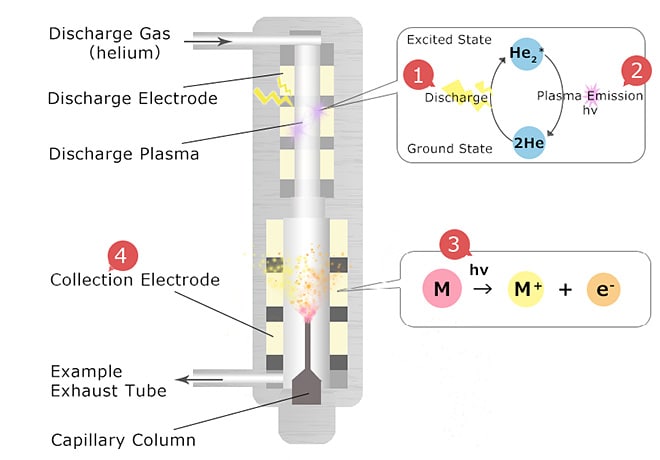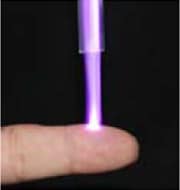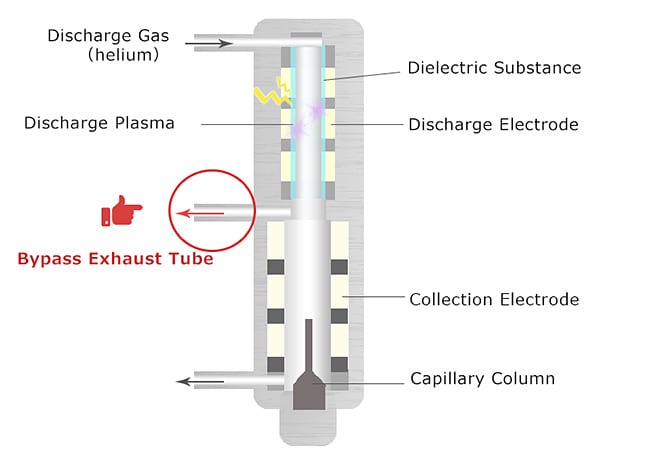Dielectric-Barrier Discharge Ionization Detector
Features of BID
Shimadzu's proprietary technology has been adopted for the BID detector, which incorporates ionization via a new dielectric barrier discharge plasma.

It is more sensitive than conventional detectors, is able to detect components that were difficult to date for FID, TCD and other all-purpose detectors, and further, retains long term stability.
| Organic compounds | Up to 0.1 ppm (Up to 1.5 pg/sec) |
(Hydrogen used) |
|
| All compounds except carrier gases | Up to 10 ppm | ||
ionization detector |
All compounds except He and Ne | <0.1 ppm (<1.0 pg/sec) |
*) This differs depending on the measurement conditions and the samples.
As per Shimadzu analysis examples.
The secret is...
Conventional Discharge Ionization Detector
Detectors in which samples are ionized by excited helium are well known. For example, pulsed discharge photo-ionization detectors (PDD) quantify samples as shown below.
- 1A high voltage pulse is applied between discharge electrodes in a He gas, generating a discharge.
- 2He molecules transition to an excited state due to the discharge. Afterwards, in the process of returning to their ground state, they release ultraviolet light across a wide energy range (17.7 eV).
- 3The light energy from this ultraviolet light strips the electrons from the sample, ionizing it.
(M→M+ + e-)
(!) The irradiation energy of He is a high 17.7 eV, and is capable of ionizing all samples other than Ne. - 4The electrons generated are taken up by the electrode, and are detected as a current.

Proprietary BID Technology
At Shimadzu, the BID technology was developed by incorporating our proprietary technology into a conventional detector. Shimadzu Proprietary Technology's features are as follows.
(1) Dielectric Barrier Discharge System
When the discharge is generated, the discharge electrodes used to create the discharge are covered in a dielectric (quartz glass). Covering them in a dielectric offers the following advantages.
- The discharge current is limited, suppressing overheating of the electrodes and discharge chamber due to large currents, so a stable discharge is formed. (The plasma generated is at low temperature, close to room temperature.)
- The plasma generated by the discharge makes no contact with the electrode because of the dielectric, so damage to the electrode from sputtering does not occur, producing excellent long term stability.

As noted earlier, the dielectric barrier discharge generates a plasma at a very low gas temperature (close to room temperature). There is almost no sensation of heat even if the plasma makes contact with the skin. A feature of this low heat generation is that temperature fluctuations at the plasma generating component are suppressed, which helps to minimize detector output noise.

(2) Patented Bypass Exhaust Tube Technology! Patent No. 05136300
A bypass exhaust tube is connected between the plasma generating component and the electric charge collector. This configuration ensures the disposal of some of the discharge gas used for plasma generation.
In order to maintain the purity of the discharge gas, it is preferable if the flowrate of discharge gas at the plasma generating component is at or above a certain level. At the same time, if the flow of discharge gas at the electric charge collector is excessive, the sample gas will inadvertently be diluted. Accordingly, installing a bypass exhaust controls the flowrate to the electric charge collector while maintaining the flowrate at the plasma generating component.

- Analysis Example:
- →Analysis of SF6 Insulation Gas via GC-BID
Researcher's Comments
Dielectric barrier discharge is an old technique that has been used since the time of so-called silent electric discharge. However, progress in understanding atmospheric pressure plasma generated by discharge is recent. Combining information with respect to atmospheric pressure plasma from cooperative research at Osaka University with Shimadzu’s precision measurement technology has enabled the realization of a high sensitivity ionization detector utilizing these discharge characteristics. We would like to take this opportunity to express our gratitude to Associate Professor Katsuhisa Kitano of Osaka University, who has been involved in research and development from the beginning.

Kei Shinada
(Technology Research Laboratory,
Shimadzu Corporation)



